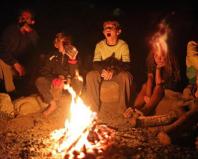Designer's Handbook Part 1 Heating. Internal sanitary installations. Section I. Thermal conditions of the building
Section I. a common part
Chapter 1. Some physical quantities
Section II. Thermal conditions of buildings
Chapter 2. Internal and external climatic conditions
Chapter 3. Heat transfer through barriers
Chapter 4. Air permeability building materials and designs
Chapter 5. Moisture transfer and humidity regime of fences
Chapter 6. Protective properties external fencing. General calculation sequence
Chapter 7. Thermal properties fencing
Chapter 8. Air-moisture-proof properties of fences
Chapter 9. Outdoor air infiltration through enclosures
Section III. Heating
Chapter 10. Classification of heating systems and their scope
Chapter 11. Estimated heat output of the building heating system
Chapter 12. Heating devices
Chapter 13. Water heating
Chapter 14. Steam heating of low and high pressure
Chapter 15. Air heating
Chapter 16. Panel radiant heating
Chapter 17. Electric heating
Chapter 18. Features of heating of agricultural buildings and structures
Chapter 19. Stove heating
Section IV. Hot water supply
Chapter 20. Internal hot water systems
Section V. Thermal inputs
Chapter 21. Connection of residential buildings, as well as public and utility consumers heat to water heating networks
Chapter 22. Accession industrial enterprises to water heating networks and steam pipelines
Chapter 23. Instrumentation and automation
Chapter 24. Calculation and selection of equipment for thermal inputs
Section VI. Water pipes
Chapter 25. General information
Chapter 26. Plumbing systems and diagrams
Chapter 27. Regulatory data
Chapter 28. Water supply networks
Chapter 29. Water flow meters (water meters)
Chapter 30. Hydraulic calculation water supply networks
Chapter 31. Pumps and pumping units
Chapter 32. Water tanks and reservoirs
Chapter 33. Construction of a water pipeline in special natural conditions
Section VII. Sewerage
Chapter 34. General information
Chapter 35. Sewage systems and schemes
Chapter 36. Receivers Wastewater
Chapter 37. Sewer networks
Chapter 38. Hydraulic calculation of pipelines
Chapter 39. Pumping units
Chapter 40. Local wastewater treatment plants and other special devices
Chapter 41. Building drains
Chapter 42. Sewerage networks during the construction of buildings in special natural conditions
Section VIII. Gas supply
Chapter 43. General information
Chapter 44. Gas supply to residential and public buildings
Chapter 45. Gas supply to industrial enterprises
Section IX. Calculation tables
Chapter 46. Tables for hydraulic calculation of heating systems
Chapter 47. Tables for hydraulic calculation of water supply networks
Chapter 48. Tables for hydraulic calculation of sewer networks
Applications
1. Pipes and connecting parts to them
2. Fittings
3. Equipment for water and steam heating
4. System equipment electric heating
5. Equipment for hot water supply and gas supply systems
6. Equipment for water supply and sewerage systems
7. General purpose equipment
Don't be lazy to leave your comment on the book
Name: Handbook for designers of industrial, residential and public buildings and structures Part 2. Ventilation and air conditioning (internal sanitary installations)
I. G. Staroverova
Publisher: Publishing house of literature on construction
Year: 1969
Pages: 408
Format: DjVu
Size: 13.1 Mb
ISBN: -
Quality: good
Series or Issue: -
From the publisher
The book contains reference information on the calculation and design of foundations and foundations of buildings and structures for various purposes. Are being considered physical properties and basic laws of soil mechanics, latest designs foundations, features of their design and execution of work depending on the nature of the soil. Are given modern methods calculation of settlement and stability of foundations and strength of foundations. Methods for artificially strengthening foundations and strengthening existing foundations are outlined. The text of the reference book is consistent with the latest regulatory documents, in particular, with the new edition Building codes and Rules. Special attention The reference book is addressed to the requirements of limit state calculations and design, taking into account modern mechanization of work and new industrial types of foundations.
The book is intended for engineering and technical workers in design and construction organizations.



DESIGNER'S HANDBOOK
In three parts
Part 1. Heating.
Part 2. Water supply and sewerage.
Part 3. Book 1. Ventilation and air conditioning.
Part 3. Book 2. Ventilation and air conditioning.
Part 1. Heating.
Provides basic information on calculations thermal regime premises, selection, design and calculation of heating systems for buildings and structures. A methodology for using the heat of geothermal waters and solar energy is outlined. Ed. The 3rd was published in 1975 under the title. "Heating, plumbing and sewerage."
Internal sanitary installations. V 60 V 3 hours 4.1. Heating / V. N. Bogoslovsky, B. A. Krupnov, A. N. Scanavi and others; Ed. I.G. Staroverova and Yu.I. Schiller.-4th ed., revised. and additional - M.: Stroyizdat, 1990. - 344 p.: ill. - (Designer's Handbook).
Part 2. Water supply and sewerage.
Provides basic information on calculation and design internal systems water supply, sewerage, hot water supply and gas supply for residential, public and industrial buildings and structures. Ed. The 3rd was published in 1975 under the title: Part 1. “Heating, water supply and sewerage.” Part 1 “Heating” was published in 1989.
For engineering and technical workers.
Internal sanitary installations. V 60 V 3 hours Part 2. Water supply and sewerage / Yu. N. Sargin, L. I. Druskin, I. B. Pokrovskaya and others; Ed. I. G. Staroverov and Yu. I. Schiller. - 4th ed., revised. and additional - M.: Stroyizdat, 1990. - 247 p.: ill. - (Designer's Handbook).
Part 3. Book 1. Ventilation and air conditioning.
The basic information necessary for designing air ventilation systems is provided. The calculation of air conditioning and aeration systems for industrial buildings, as well as air ducts and pneumatic transport is given. The 4th edition has been revised and expanded taking into account the latest theoretical research and new regulatory documents. Ed. Part 3 came out in 1978. Parts 1 and 2 came out in 1990.
For engineering and technical workers of design and construction organizations.
Internal sanitary installations. At 3 o'clock B60 Ch.Z. Ventilation and air conditioning. Book
1/V.N. Bogoslovsky, A.I. Pirumov, V.N. Posokhin et al.; Ed. H.H. Pavlova and Yu.I. Schiller.-4th ed.,
reworked and additional - M.: Stroyizdat, 1992. - 319 p.: ill. - (Designer's Handbook).
Part 3. Book 2. Ventilation and air conditioning.
The main issues of designing air conditioning systems, air distribution in rooms, utilization of low-grade heat are considered, and the calculation of air ducts is given. Ed. 4th reworked
and supplemented taking into account the results of the latest theoretical research and new regulatory documents. Ed. The 3rd edition was published in 1978. Parts 1 and 2 of the 4th edition were published in 1990.
For engineering and technical workers of design and construction organizations.
Internal sanitary installations. At 3 hours. Part 3. B60 Ventilation and air conditioning. Book 2/B. V. Barkalov, N. N. Pavlov, S. S. Amirdzhanov and others; Ed. N.N. Pavlova and Yu.I. Schiller.-4th ed., revised. and additional - M.: Stroyizdat, 1992. - 416 p.: ill. - (Designer's Handbook).
To view djvu book format, you need to use the appropriate program, or a small free utility WinDjView, which you can
4th edition. Basic information on calculating the thermal conditions of premises, selection, design and calculation of heating systems for buildings and structures is provided. A methodology for using the heat of geothermal waters and solar energy is outlined. The 3rd edition was published in 1975 under the title. "Heating, plumbing and sewerage." For engineering and technical workers of design and construction organizations.
Preface
Section I. Thermal conditions of the building
Chapter 1. Indoor and outdoor climatic conditions
1.1. Meteorological conditions indoors
1.2. Estimated characteristics of the outdoor climate for the cold season
Chapter 2. Heat transfer through barriers
2.1. Stationary heat transfer
2.2. Transient heat transfer
2.3. Heat transfer through a complex enclosure with two-dimensional elements
Chapter 3. Air permeability of building materials and structures
Chapter 4. Moisture transfer and humidity regime of the fence
Chapter 5. Protective properties of external fences
5.1. General calculation sequence
5.2. Required (minimum permissible) heat transfer resistance
5.3. Optimal (economically feasible) resistance to heat transfer of the fence
5.4. Thermal protection of light openings and doors
5.5. Required thermal resistance of fencing
5.6. Required thermal resistance of floors
5.7. Required air permeation resistance
5.8. Required vapor permeation resistance
Chapter 6. Infiltration of outside air through the enclosure
6.1. Infiltration of outdoor air in industrial and one-story public buildings
6.2. Air infiltration in multi-storey public buildings equipped with mechanical ventilation systems
Section II. Heating
Chapter 7. Classification and selection of heating systems
7.1. Main types of heating systems
7.2. Selecting a heating system
7.3. Features of choosing a heating system in a building with variable thermal conditions
Chapter 8. Thermal power of the heating system
8.1. Room heat balance
8.2. Heat loss in the room
8.3. Heat gain into the room
8.4. Calculated thermal power heating systems
8.5. Heat loss of a building according to enlarged meters
Chapter 9. Heating devices
9.1. Types of heating devices
9.2. Selection and placement of heating devices
9.3. Heat transfer of heating devices
9.4. Estimated temperature of water coolant in heating devices
9.5. Thermal calculation of devices
9.6. Examples thermal calculation heating devices
9.7. Regulation of heat transfer of heating devices
9.8. Installation of heating devices
Chapter 10. Water heating
10.1. General information
10.2. System classification
10.3. System Design Sequence
10.4. System selection
10.5. Hydraulic pressure in system
10.6. System design
10.7. Design circulation pressure in the system
10.8. Methods for hydraulic calculation of a heating system
10.9. Hydraulic calculation of the system based on specific linear pressure losses
10.10. Hydraulic calculation of the system based on resistance characteristics
10.11. Hydraulic calculation of a single-pipe system with risers of a unified design and dead-end water movement in the mains according to the characteristics of hydraulic resistance
10.12. Hydraulic calculation of gravity system
Chapter 11. Steam heating
11.1. Classification of steam heating systems
11.2. Guidelines for selecting steam heating systems and circuits
11.3. Design guidelines
11.4. Calculation of steam pipelines
11.5. Calculation of condensate pipelines
11.6. Instructions for selecting and calculating equipment
Chapter 12. Air heating
12.1. General information
12.2. Systems calculation air heating
12.3. Examples of calculation of air heating systems
Chapter 13. Panel radiant heating
13.1. General information
13.2. Heating panel designs and system diagrams
13.3. Thermal calculation of panel radiant heating
Chapter 14. Electric heating
14.1. Classification and scope of application of electric heating systems
14.2. Radiant-convective electric heating
14.3. Electric locomotive stuffy heating
14.4. Infrared electric heating
Chapter 15. Features of heating of agricultural buildings and structures
15.1. Heating systems in livestock buildings
15.2. Poultry premises
15.3. Cultivation facilities for year-round cultivation of vegetables
Chapter 16. Using the heat of solar energy
16.1. Classification solar systems hot water supply and heating
16.2. Estimation of available solar energy
16.3. Classification and selection of solar energy collectors (SEC)
16.4. Classification and selection of heat accumulators
16.5. General provisions systems calculations solar heating and hot water supply
16.6. Calculation of seasonal hot water supply systems
16.7. Clarification of the thermal calculation of the SST, taking into account the actual characteristics of the system
Chapter 17. Using the heat of geothermal waters
17.1. Classification of geothermal waters
17.2. Specifics of geothermal coolant
17.3. Technical and economic assessment of options for systems using the heat of geothermal waters
17.4. Schematic diagrams of geothermal heating systems
17.5. Geothermal heat consumers
Appendix I. Some physical quantities
Appendix II. Tables for hydraulic calculation of heating systems
Appendix III. Steel pipes and connecting parts with them
Appendix IV General information about fittings
Appendix V. Cranes
Appendix VI. Shut-off valves
Appendix VII. Valves
Appendix VIII. Valves
Appendix IX. Steam traps
Appendix X. Heating appliances
Appendix XI. Heating units
Appendix XII. Equipment for electric heating systems
Appendix XIII. Pumps
Subject index




